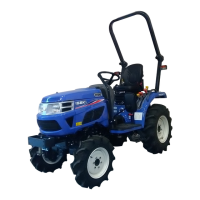TM3217, 3247, 3267
36
Position Control
Position control is used when attaching or detaching
implements and other operations requiring the imple-
ment to be kept at a constant height above the ground. It
is also used with tool bars having flexible row units and
implements equipped with gauge (support) wheels.
FIG. 59: The position control lever maintains hitch posi-
tion at a constant height in relation to the tractor. As the
position control lever (1) is moved backward, hitch and
implement are raised. Moving the lever forward will low-
er hitch to selected position. Each lever setting provides
a specific hitch and implement position.
The front lever stopper (2) can be set to contact the po-
sition control lever in the implement work position. This
enables the implement to be returned to the identical
position after the hitch has been raised for turning, trans-
porting, etc.
The rear lever stopper (3) can be set to limit raising
height, if required.
NOTE: When starting engine, ensure implement is
lowered to the ground and lever is fully forward.
This reduces load on starter due to hitch trying
to raise when engine is cranked.
To begin work, align the tractor and implement in the
field and move the position control lever (1) forward (to-
ward DOWN). Adjust implement height using the posi-
tion control lever and set the adjustable stopper (2 and 3)
as desired.
When turning, move position control lever backward (to-
ward UP) to raise the implement and permit completion
of turn. Return the implement to the work position by se-
lecting the position control lever to the previous position
against the stop.
To finish work and transport, pull position control lever
rearward fully to UP position.
Lowering Rate Control Knob
FIG. 60: The lowering rate knob (1) adjusts the rate
of drop of the 3-point hitch and implement. Turn knob
clockwise to slow drop rate (increase lowering time),
counterclockwise to increase drop rate (decrease lower-
ing time). Turning the knob fully clockwise will lock the
implement (or hitch) in raised position for transport.
CAUTION: When working on or around mount-
ed implements, always lower to ground prior
to work. If implement must be raised, always
block implement and lower links securely.
FIG. 59
FIG. 60

